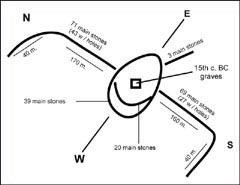|
Parsamian was able to confirm the purpose of the stones, but
she was unable to complete her investigations because of funding
limitations. Nevertheless, her work was enough to fuel
a deep interest in the complex.
From her
findings it was clear that the site was used to watch the night
sky and solar positions, and it seemed the stones were from
a different era than that of the burial ground. Other
archeologists agreed, but lacking carbon dating or other methods
of determining the age of the stones, they were unable to agree
on a specific date, and so the site was ascribed as 3rd millennium
BC.
Parsamian
published her findings beginning in 1984, and shared her discovery
with others, one of whom was Paris Herouni, the director of
the Radio Physics Measurement Institute and the designer of
the first optical radio telescope in the world, located just
above Byurakan on Aragats mountain. Herouni, an avid fan
of Parsamian's pioneering work, was fascinated with her findings.
Believing that her pioneering work at Metsamor and Sissian not
only shattered previous conceptions about when ancestral Armenians
developed their culture, but that it also pointed to a source
of civilization itself on the Armenian Plateau, Herouni began
to study her work carefully, as well as that by Gerald Hawkins
regarding Europe's henges.
Using
Parsamian's original findings, Herouni organized four expeditions
to the site between 1994 and 1996, each during an equinox or
solstice. He and his assistants brought chronometers,
telescopes and other astronomical equipment to test the accuracy
of the stones. "We even took a helicopter and flew over the
sight to accurately plot the area," Herouni says with a laugh.
"I had cartographers and photographers all over the site, we
marked and catalogued the stones, took measurements—it was like
a small army had invaded the area."
 Herouni
and his team soon verified Parsamian's findings: the stones
were indeed an astronomical instrument, and it is still very
accurate. Holding a topographical map of the site,
Herouni points out the site's features, "Inside the complex
there are 204 main stones. All of them are made of basalt.
They rise between a half a meter to 3 meters tall,, their bases
are up to one and a half meters wide, and they weigh up to ten
tons each. Of these main stones, 76 have apertures, 63
are stable, 16 declining, and 90 lying on their sides.
45 are damaged, especially the apertures." Herouni thinks
the damages were caused by invading armies and early Christians
trying to destroy the pagan worship site. Herouni
and his team soon verified Parsamian's findings: the stones
were indeed an astronomical instrument, and it is still very
accurate. Holding a topographical map of the site,
Herouni points out the site's features, "Inside the complex
there are 204 main stones. All of them are made of basalt.
They rise between a half a meter to 3 meters tall,, their bases
are up to one and a half meters wide, and they weigh up to ten
tons each. Of these main stones, 76 have apertures, 63
are stable, 16 declining, and 90 lying on their sides.
45 are damaged, especially the apertures." Herouni thinks
the damages were caused by invading armies and early Christians
trying to destroy the pagan worship site.
A bird's-eye
view of the site is impressive. The complex is centered
around 39 stones in the configuration of an egg, with its main
axis lying East to West. "From East to West, this 'egg'
stretches 43 meters," Herouni adds, "37 meters from North to
South." Dissecting this central form is an arc of twenty
stones that bends to the West, "forming an inner elliptical
shape, a 'Khorda'." The excavated graves lie inside the
khorda, which led archeologists to originally think the stones
were placed there about the same time.
|